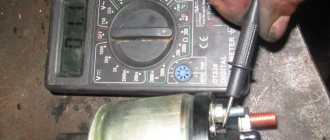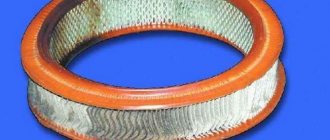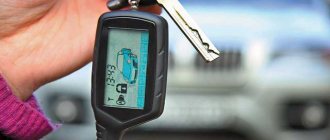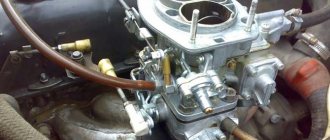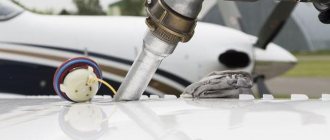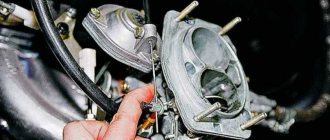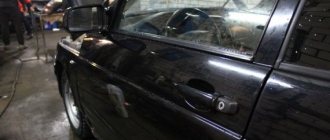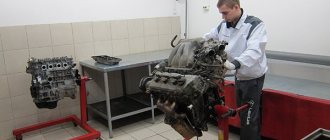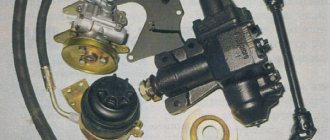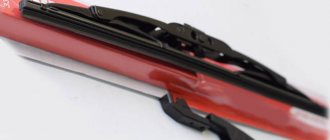Gasoline pump for carburetor VAZ 2107
One of the mechanisms of the power supply system of any engine is the fuel pump. The startup and operation of the power unit directly depends on its performance. Mechanical fuel pumps of the diaphragm type DAAZ 2101 were installed on carburetor “sevens”. Thanks to the simple design, the mechanism is repairable. However, it often causes problems for Zhiguli owners. Therefore, it is worth dwelling on the operation and malfunctions of this unit in more detail.
Main functions
The job of the fuel pump is to move fuel from the tank to the carburetor.
The power supply system of a VAZ 2107 with a carburetor engine consists of the following elements: 1 - fuel pump; 2 — hose from the fuel pump to the carburetor; 3 - carburetor; 4 — rear tube; 5 — sensor for level indicator and fuel reserve; 6 — safety shield; 7 — tank ventilation tube; 8 — fuel tank; 9 — gaskets; 10 — fuel tank mounting clamp; 11 — front tube; 12 — fine fuel filter
The design of the unit is not ideal, so it is one of the weak points in the car. This is explained by the fact that the impact of constant loads and low quality gasoline lead to natural wear and tear of the elements. This is what causes the device to fail. If a problem occurs with the pump, the engine begins to work intermittently or stops functioning altogether.
The fuel pump has a simple design, but is one of the weak points of the car
Design and operating principle
The mechanism is made of several parts connected to each other by fastening elements. There are two fittings in the upper part of the body through which fuel is supplied and pumped into the carburetor. The design includes a lever that allows you to manually pump gasoline from the tank into the fuel system, which is important after the car has been parked for a long time. The main elements of the node are:
- pusher;
- spring;
- balance;
- lid;
- cover screw;
- screw;
- mesh filter;
- membranes (working and safety);
- lower and upper plates;
- stock;
- valves (inlet and outlet);
- manual pumping lever.
Fuel pump design: 1 - discharge pipe; 2 - filter; 3 - body; 4 - suction pipe; 5 - cover; 6 - suction valve; 7 — rod; 8 — manual fuel pumping lever; 9 - spring; 10 - cam; 11 — balancer; 12 — mechanical fuel pumping lever; 13 — bottom cover; 14 — internal spacer; 15 — external spacer; 16 - discharge valve
The principle of operation of a classic fuel pump is based on creating the pressure necessary to maintain the required fuel level in the carburetor chamber. Thanks to the diaphragm, the flow of gasoline stops or decreases when a maximum pressure value is established in the fuel line. On carburetor “sevens” the fuel pump is located under the hood on the left side of the cylinder block. It is secured to two studs through a thermal spacer and gaskets, which are also used for adjustment. The spacer is also a guiding part for the pump rod.
The device operates in the following order:
- the pump pusher is driven by a drive cam operating from the gas distribution mechanism;
- the membranes located inside the gas pump move and alternately create pressure and vacuum in the chamber;
- if the pressure decreases, the outlet valve closes and fuel flows through the inlet valve;
- when the pressure increases, the valve at the pump inlet closes, and gasoline is supplied through a hose to the carburetor.
Under the action of the pusher, which is controlled by the gas distribution mechanism, a vacuum and pressure are alternately created in the fuel pump chamber, due to which the fuel suction strokes and its supply to the carburetor are ensured.
Which fuel pump is better
When there are problems with the fuel pump, the question of choosing a new device often arises. Owners of Zhiguli cars mainly prefer products of two. If problems arise with the factory mechanism, for example, when it overheats, many change it to the second option, explaining that Pekar pumps do not have a tendency to form a vapor lock, which causes defects in the operation of the device in hot weather. In fact, this opinion is wrong, since they also have this problem, as evidenced by numerous reviews from car owners. It is also worth considering that Pekar costs 1.5–2 more than DAAZ. Therefore, a standard fuel pump is the best choice based on criteria such as reliability, price and quality. The cost of a factory pump is 500–600 rubles.
The Pekar fuel pump, along with the DAAZ, is considered one of the best for classic Zhiguli cars.
Table: parameters of different fuel pumps
QH petrol pumps are manufactured in the UK, while OTA petrol pumps are manufactured in Italy. However, these devices have some features: the QH pump does not have a lever for manual pumping of fuel, and the housing is non-separable. The Italian mechanism has excellent parameters compared to others, but its price is almost 3 times higher than Russian products.
Reasons for failure and replacement
VAZ 2110 connecting an electric fuel pump
Fuel pump failure occurs for several reasons:
- driving with an empty gas tank;
- failure to replace the fuel filter on time and much more.
Due to non-compliance with such simple rules, the electric fuel pump wears out. Therefore, malfunctions in the fuel system occur prematurely.
Note: it is necessary to change fuel filters on time, especially when filling with low-quality gasoline. Follow the main rule: the gas tank should always be more than half full.
How to check the fuel pump?
The technical condition of the car, including the fuel supply system, can be checked using a car diagnostic scanner. It is enough to have an ODB2 connector and an information output device (phone, tablet, PC). Of those on the market, we can recommend Scan Tool Pro Black Edition.
This car scanner is available at a fairly affordable price, is compatible with most cars since 1993, has wide functionality and is quite easy to use. The advantages of this particular model are not only engine diagnostics, but also other subsystems. All information about the condition of your car and a description of existing faults is displayed on the phone/tablet screen in Russian.
If the fuel pump does not start when the ignition is turned on, the check begins by looking for electrical problems:
- Checking the fuse. To do this, find the fuse box, find out which one is responsible for the fuel pump (check the diagram) and inspect it for burns. It’s even better to immediately replace it with a known working one with the same characteristics and see if it works;
- Checking the fuel pump control relay. It can be installed near the fuse box, injection control unit or other places. To check the pump relay, you need to remove and measure the winding resistance with an ohmmeter. If the indicator tends to infinity, then there is a cliff;
- Check current supply. To do this, you need to get the fuel pump itself without disconnecting it from the power supply. Turn on the ignition and measure the voltage at the terminals; normally it should be 12-12.5 V. If the motor does not work, it will have to be replaced;
- You can ring the fuel pump motor itself. Measure the resistance of the stator winding with an ohmmeter, first at the motor contacts for a break, then between the contact and the housing. If there is conductivity, it means that the stator winding is short-circuited to the housing;
- If everything is normal, evaluate the condition of the mesh filter. Perhaps it is clogged to such an extent that it does not allow the required amount of gasoline to pass through, in which case it must be cleaned and used further;
- Check the check valve, which prevents gasoline from returning back from the fuel line. Either test with a pressure gauge (the indicator should be no more than 0.3 MPa), or clean the valve and see how the engine operation changes;
- And finally, check the gasoline pressure in the system. To do this, connect a pressure gauge to the fuel rail and measure the pressure with the engine off, idling and while driving. When the engine is turned on, the pressure gauge reading should be between 3-3.7 atm.
Below is a short video instruction on checking the fuel pump pressure.
If the check shows that the fuel pump is faulty, it is not repaired, but replaced. All the elements are adjusted too finely to try to repair something without special equipment.
When buying a gas pump, it is better to give preference to good, well-known brands rather than a suspiciously cheap “confiscated” product. Then there is a chance that the new pump will last at least 100 thousand km and will not create problems.
Preparation for repair
Before starting repairs and replacing the electric fuel pump, you must:
- disconnect the negative terminal on the battery;
- remove the cap from the gas tank to prevent the creation of rarefied vapors;
- check the fuel level, it should be at the middle level in the gas tank, but no more;
- You should also place a fire extinguisher nearby, just check its expiration date in advance.
To relieve pressure in the pipeline, you must start the engine and leave it running until it stops completely.
Note: work must be carried out using a lamp with a protective cap. You need to prepare clean rags and plastic containers in advance for the fuel pump to be removed, as there will be residual fuel in it.
After completing the preparatory work, recline the rear seat and remove the protective cap of the gas tank.
Replacement
VAZ 2110 electric fuel pump diagram
Carry out work carefully, legibly and consistently:
- disconnect the gas tank connector;
- loosen the clamp;
- unscrew the tubes using special wrenches;
- remove the rubber gaskets;
- unscrew the eight bolts on the body;
- remove the sealing ring;
- remove the fuel pump.
Note: replace the rubber gaskets on both pipeline fittings using a repair kit. The fuel pump must be placed on a pre-prepared rag or in a plastic container.
VAZ 2110 electric fuel pump and its removal
The pump is gradually pulled up and tilted towards the backs of the seats to avoid deformation of the float. Remaining gasoline may spill during this work. The last thing is to remove the rubber gasket. When replacing not the entire module, but only the fuel pump, you will have to spend time and effort:
- remove the locking spring from one guide;
- compress the fixation plates;
- disconnect the module;
- remove the fence mesh;
- disconnect the terminals from the pump and fuel level sensor>;
- remove the polypropylene fuel pipe, it is connected securely, so you will need to act carefully, but with effort;
- remove and replace the pump.
Note: replacing the fuel pump must be done with replacing the fuel filter.
Sources
- https://prokarbyrator.ru/remont-karbyuratornogo-avtomobilya/elektrobenzonasos-dlya-karbyuratora-nizkogo-davleniya-ustrojstvo-i-ustanovka.html
- https://alex-sachkov.ru/ustanovka-elektrobenzonasosa-na-karbyuratornyy-vaz-21099-svoimi-rukami
- https://scart-avto.ru/remont/benzonasos-shema-raboty-benzonasosa-uhod-i-profilaktika/
- https://FB.ru/article/283536/elektrobenzonasos-na-karbyurator-harakteristiki-ustanovka
- https://KrutiMotor.ru/elektricheskij-benzonasos-na-karbyurator/
- https://MasteraVaza.ru/sistema-pitaniya-dvigatelya/benzonasos-sistema-pitaniya-dvigatelya/elektrobenzonasos-vaz-2110-618
- https://VazNeTaz.ru/benzonasos
About the design
DAAZ fuel cells are installed on cars of the “classic” family. Specifically on the “seven”, the pump is capable of pumping fuel in a volume of up to 60 liters per hour. In this case, the pressure generated in the system is about 20-30 kPa.
The design of this element includes the following parts:
- Cover and cover screw.
- Mesh filter.
- Upper part of the body.
- Top plate.
- Screws connecting the body parts.
- Fastening nut.
- Working diaphragms.
- Stock.
- Bottom plate.
- Distance spacers.
- Manual pumping lever.
- Lower part of the body.
Connection diagram
The circuit is very easy to connect.
Even if this is your first time connecting a relay, all the contacts are numbered and it is unlikely that you will make a mistake by mixing up the wires. The pump was installed strictly vertically immediately behind the radiator fan.
Since our EBN is vibrating, it makes a loud sound if you don’t put a rubber gasket under it. Initially, I cut out a piece of strip from a bicycle tube, folded it several times, and attached it all with 2 bolts. As a result, the sound of the pump was audible even when the car was moving, very loud. Next, I cut out the gaskets from the fuel pipe and installed it all on the car.
The sound has become quieter, you can’t hear it when moving, but this is not the end result. In the future I will make a rubber cushion of 1 cm or more. For the experiment, I removed the EBN from the mounts and simply hung it behind the hose with a wire and screwed it to the body, so that the pump was not fixed, but simply hung on the fuel hose.
I was surprised by the result. The pump worked almost silently when the ignition was on; when the engine was running, you couldn’t even hear the pump running. I tried attaching springs instead of rubber tubes, after which I simply attached a pump to the springs, but the sound was even louder, so this is the only unpleasant situation with the EBN.
I laid all the wires in corrugation. We also do not forget that it is better to pull the + from the relay directly to the + terminal of the battery and put a 15A fuse there.
I didn’t know how much fuel it pumps from the tank, since everyone has a different length of the fuel line, different filters, maybe even more than one, so the result will be different. So far everything is fine regarding work. At speed and high revs, there is enough fuel and the car does not jerk, the spark plugs are clean. In fact, I didn’t notice any difference in operation between the EBN and the baker, the only thing is that it no longer stalls in the heat and, as it seemed to me, idling is better in cold weather.
Peculiarities
The carburetor was invented a long time ago. Received widespread use in the last century. However, over time, more and more new technologies appear and the carburetor has been replaced by injection mechanisms. The carburetor performs its task by adhering to the mechanical devices. While the injection system works thanks to electronics. Most car owners of carburetor vehicles combine it with the latest mechanisms. For example, they mount an electric fuel pump on a carburetor.
The essence of the operation of the gas pump on the carburetor is to ensure the supply of fuel from the gas tank to the cylinders. A high-pressure electric fuel pump for a carburetor is not really needed, because together with these mechanisms, electric pumps operate at low pressure, which distinguishes them from injectors, where high pressure is needed in the fuel system. In injection engines, the electric fuel pump is mounted inside the fuel tank. The electronic fuel pump on the carburetor is located under the hood.
Fuel pump drive
The VAZ 2107 fuel pump operates from a pusher (rod) and an eccentric located on the shaft of auxiliary devices (“piglet”, intermediate shaft), which is driven by the timing mechanism through a gear. Auxiliary devices include distributor, oil and fuel pumps.
Operating principle
The drive works as follows:
- the intermediate shaft rotates via a timing chain;
- the eccentric acts on the rod and pushes it;
- the rod presses the fuel pump lever, ensuring its operation.
Advantages and disadvantages of installing an electric fuel pump on a carburetor engine
In the list of main advantages after installing an electric pump on a carburetor, we should highlight the ease of starting the internal combustion engine. The engine starts quickly, both cold and hot, reducing the load on the battery and starter. As for operation, if connected correctly, there is not so much smell of gasoline in the cabin, and fuel is also consumed more economically.
If we talk about the disadvantages, then it is worth noting only the complexity of installation and the need to purchase the pump itself. Also, for normal operation of the pump, the vehicle’s electrical systems must be in good working order, as well as a normal battery charge level.
Tips and tricks
It should be noted that before purchasing a gasoline pump, you must carefully study its characteristics in terms of performance and pressure, current consumption, etc. In some cases, a situation may arise when the device is not able to work normally with a particular carburetor.
The fact is that clogged filters increase the load on the pump, as a result of which the device may overheat or fail. As a rule, in case of problems with filters, first the pump’s performance drops, then the engine may begin to work unstably, power is lost and traction deteriorates. Ignoring these symptoms not only makes it difficult to operate the car, but also significantly reduces the service life of the electric fuel pump.
Mechanical and electric fuel pump, design and principle of operation of the device, types of pumps and main malfunctions, operating features
How to determine why the fuel pump does not pump or works poorly. Fuel rail pressure, pump diagnostics. Wiring, relays, fuel pump fuses.
The causes of whistling and increased noise during operation of the fuel pump are overheating of the pump. How to diagnose and fix the problem yourself. Tips and tricks.
Step-by-step installation with photo of the fuel pump
K-contact is a signal (spark-producing) B-contact is + 12V ignition
I connected the relay according to this diagram:
The relay itself looks like this.
This is what it looks like under the hood. I put the plugs on the mechanical fuel pump that were included with the EBN and haven’t started removing them yet, otherwise you never know.
Well, what can I say based on 2 weeks of experience in using this gas pump. The car drives and does not heat up even in the heat of 30+ degrees. 140 - 150 the car began to drive much better; there is enough gasoline, consumption has not increased, in general, so far everything is good.
The maximum speed at which it was driven
I found on a foreign website a diagram for controlling the fuel pump from the ignition, maybe it will be useful to someone. I soldered this myself and it works great, when you turn on the ignition the relay turns on for about 10 seconds, which is necessary to increase the pressure in the fuel system, then we start the relay again turns on the fuel pump while the ignition coil is working
It will also be interesting
13.12.2020
Installation of fineness pump and chips
After reading the opinions of people, I came to my conclusion and its setting will be as follows:
We install the EBN only vertically!
The location of the pump under my hood is as far as possible from the engine, since it also gets hot and it would be desirable for there to be airflow to the pump. I placed the filter in front of it; it is not advisable for debris to remain in the pump. A full return to the tank is also connected. Here, too, people write differently. The fact that it is not needed, since the pump, after filling the float chamber with fuel, begins to work on its own, and with the return line it will constantly oil. Others write that a return line is needed to make it easier for the pump to work, and the carburetor won’t overfill if the needle doesn’t hold well. Theoretically, both versions are correct, but I installed everything backwards.
Purpose and design of the pump
The water pump is the most important element of the engine cooling system. Its main function is forced circulation of coolant through two circuits - small and large. On an unheated engine, antifreeze circulates in a small circle - from the water jacket of the engine to the radiator of the cabin heater and the carburetor cooling unit (or the throttle valve on the VAZ 21099 injector). When operating temperature is reached, the thermostat opens a large circuit and coolant begins to circulate through the main radiator.
